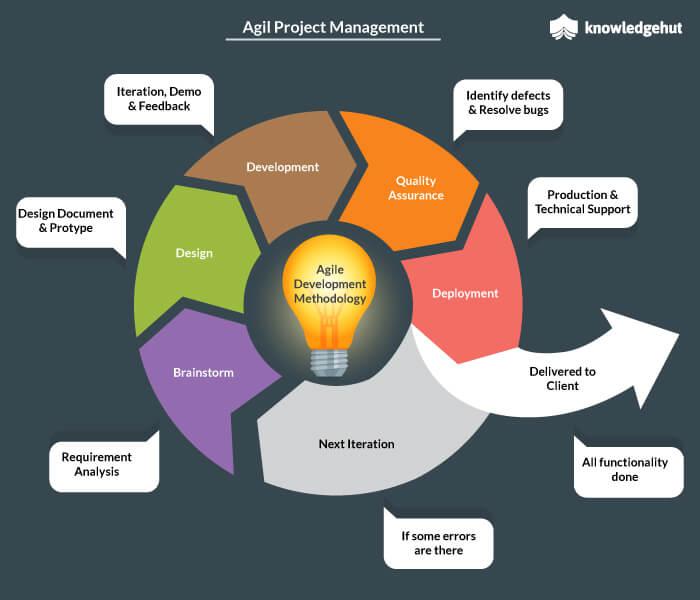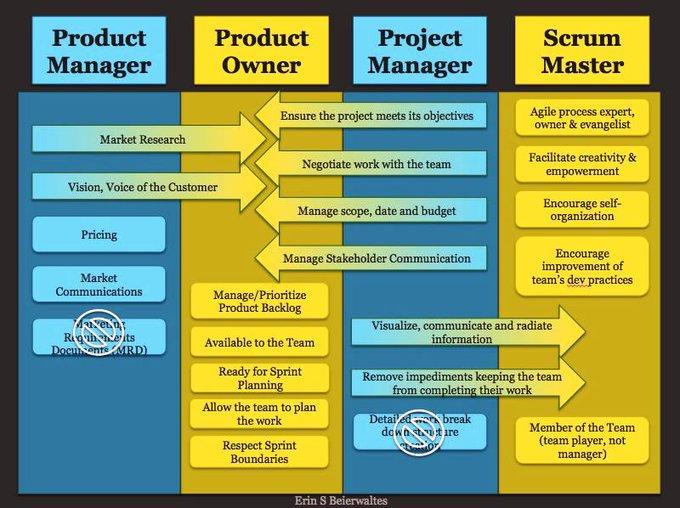Personal Agile Transformation: A Flexible Journey to Productivity
- Transfer
Hello! Next week we launch the “Development Manager” course , which is dedicated to management in all its aspects in the context of leadership of the development team. In the run-up to the launch, we are sharing with you a translation of an article that may be useful for future team leads.

Recently, a lot of things are happening due to the fact that some organizations are switching to Agile , paying more attention to self-organizing teams, additional results and maximum attractiveness for business. However, whenever someone reads about this transformation, information is usually presented in terms of the organization and how Agile affects it as a whole.

But although it may seem from the outside that an organization is a kind of faceless monolithic structure, we know that it consists of living, breathing people who themselves supply the goods and services that the organization provides. Thus, it seems to me important to consider how this will affect those who have to deal with their personal Agile transformation.
I have been involved in traditional project management for over twenty years. I also teach project management, and I have always loved telling my students that project management, like accounting, is a mature profession. Accountants talk about debits and credits, and the only thing that does change from time to time is the tax code. The lingua franca of project management over the years has been such artifacts as Gantt charts and work breakdown structures.
But to a large extent, the soil began to change under the feet of traditional (plan-oriented or cascading) project managers, especially in the last few years. This is due to the fact that the Agile approach, originally defined in the manifesto in 2001, finally began to gain a foothold in corporations. No, I would even say, to such an extent that it replaces traditional methods.
It is important enough that project managers should now not only be aware of this, but also should start thinking about learning this and gaining experience. (His wider acceptance in this bastion of traditional project management, the sixth edition of PMI, is a fairly significant event.)
On a personal level, I received Scrum Master certification.in early 2013, but never used it, at least initially. It was not so much that I was against Scrum, but the fact that I worked in traditional project management and really did not witness the first-tier revolution.
But gradually I began to realize that there would be a significant shift in the direction of using Agile and that in order to remain relevant - and I could add to the busy - you will need to begin to get acquainted with Agile projects and work in them.

Reflecting on this, I realized that perhaps the very first thing I had to deal with in Agile was the fact that the role of the project manager is not only not so significant, but in fact there is no definite role of PM as such. In the Scrum version, there are only three defined roles - Scrum Master, the product owner and the development team.
When I received Scrum certification, I already realized that it was a different type of role. As a project manager, I could - and should - do all the planning with my team. But when it comes time to decide who did what and when, it was always my job. This is a very large command and control structure. And not only did I expect to lead the team, the team expected to lead it.
But in Agile everything is different. In this role, I am more an assistant or a coach, rather than a team leader. The team organizes itself, and this means that although I can help remove obstacles for them, my task is not to tell them what to do as such. Their task is to find out what to do in a team, and Scrum Master to help and train.
Below, you will find some helpful tips on how to succeed in Agile transformation.
This is a major shift not only for project managers, but also for teams. The project manager should stop being policy makers and begin to provide assistance. For many managers, this is a very difficult transition. They do not know how not to lead. And, most likely, if they were PM for a long time, they are very used to using a scheduler such as MS Project. But the Scrum team does not necessarily need such a tool, preferring workflow tools, such as Jira, to track progress.
The problem is that the traditional project manager must hold back, telling the team what to do when they ask. He or she can remove obstacles when they arise. But his or her best advice when asked what a team member should do is “share with the team.” In a sense, he or she should rethink what he knows and throw some of his skills out the window.

And not only the prime minister may have a problem with adapting to this new reality. Imagine a team member who is used to receiving instructions on what to do in a hierarchical system. Now he or she is faced with the need to be independent to a certain extent. Some prefer not to experience this experience.
And although Agile can be used for many different projects, it is still more actively used in software development environments. And some developers, for example, who are accustomed to working alone, now have to meet daily not only with the team, but also with the “business”. For some, it is outside their comfort zone. I talked to a woman at the Agile conference, which informed me that several developers on her team were asked to move or leave the company when Agile appeared.
I think the main conclusion here is acceptance of changes and adaptation. (Ironically, the distinctive features of Agile itself.) Some people just prefer to do things the way they always did. And then, when change overtakes them - as, of course, it happens in the agile world - they cannot make changes and find themselves outside, looking inward.
As soon as I realized that I needed to get into that world, I made the transition not only by learning, but also by applying flexible thinking. (This is exactly what the Agile-trainers team helps.) I started reading everything I could, doing networking as much as I could, and then when the time came, I sent this knowledge and my years in project management to a company that is Agile-ready, still saw the value of both approaches. And when I let go of the need to control the situation and realized that I needed to be a coach and an assistant, I found that everything fell into place.
Traditionally, we are waiting for your comments and invite you to an open lesson , which Stanislav Mikhalsky , Director of Development at Biglion Technologies , will already hold today .

Recently, a lot of things are happening due to the fact that some organizations are switching to Agile , paying more attention to self-organizing teams, additional results and maximum attractiveness for business. However, whenever someone reads about this transformation, information is usually presented in terms of the organization and how Agile affects it as a whole.

But although it may seem from the outside that an organization is a kind of faceless monolithic structure, we know that it consists of living, breathing people who themselves supply the goods and services that the organization provides. Thus, it seems to me important to consider how this will affect those who have to deal with their personal Agile transformation.
I have been involved in traditional project management for over twenty years. I also teach project management, and I have always loved telling my students that project management, like accounting, is a mature profession. Accountants talk about debits and credits, and the only thing that does change from time to time is the tax code. The lingua franca of project management over the years has been such artifacts as Gantt charts and work breakdown structures.
But to a large extent, the soil began to change under the feet of traditional (plan-oriented or cascading) project managers, especially in the last few years. This is due to the fact that the Agile approach, originally defined in the manifesto in 2001, finally began to gain a foothold in corporations. No, I would even say, to such an extent that it replaces traditional methods.
It is important enough that project managers should now not only be aware of this, but also should start thinking about learning this and gaining experience. (His wider acceptance in this bastion of traditional project management, the sixth edition of PMI, is a fairly significant event.)
On a personal level, I received Scrum Master certification.in early 2013, but never used it, at least initially. It was not so much that I was against Scrum, but the fact that I worked in traditional project management and really did not witness the first-tier revolution.
But gradually I began to realize that there would be a significant shift in the direction of using Agile and that in order to remain relevant - and I could add to the busy - you will need to begin to get acquainted with Agile projects and work in them.

Reflecting on this, I realized that perhaps the very first thing I had to deal with in Agile was the fact that the role of the project manager is not only not so significant, but in fact there is no definite role of PM as such. In the Scrum version, there are only three defined roles - Scrum Master, the product owner and the development team.
When I received Scrum certification, I already realized that it was a different type of role. As a project manager, I could - and should - do all the planning with my team. But when it comes time to decide who did what and when, it was always my job. This is a very large command and control structure. And not only did I expect to lead the team, the team expected to lead it.
But in Agile everything is different. In this role, I am more an assistant or a coach, rather than a team leader. The team organizes itself, and this means that although I can help remove obstacles for them, my task is not to tell them what to do as such. Their task is to find out what to do in a team, and Scrum Master to help and train.
Below, you will find some helpful tips on how to succeed in Agile transformation.
This is a major shift not only for project managers, but also for teams. The project manager should stop being policy makers and begin to provide assistance. For many managers, this is a very difficult transition. They do not know how not to lead. And, most likely, if they were PM for a long time, they are very used to using a scheduler such as MS Project. But the Scrum team does not necessarily need such a tool, preferring workflow tools, such as Jira, to track progress.
The problem is that the traditional project manager must hold back, telling the team what to do when they ask. He or she can remove obstacles when they arise. But his or her best advice when asked what a team member should do is “share with the team.” In a sense, he or she should rethink what he knows and throw some of his skills out the window.

Be a Scrum Master, Not a Scrum Manager https://t.co/ohOBBzH5Lb #agile #scrum #dev @HyperRTs @DNR_CREW pic.twitter.com/XrmsCAdzwK
- Seth G. (@Nicko_iCorplife) October 14, 2017
And not only the prime minister may have a problem with adapting to this new reality. Imagine a team member who is used to receiving instructions on what to do in a hierarchical system. Now he or she is faced with the need to be independent to a certain extent. Some prefer not to experience this experience.
And although Agile can be used for many different projects, it is still more actively used in software development environments. And some developers, for example, who are accustomed to working alone, now have to meet daily not only with the team, but also with the “business”. For some, it is outside their comfort zone. I talked to a woman at the Agile conference, which informed me that several developers on her team were asked to move or leave the company when Agile appeared.
I think the main conclusion here is acceptance of changes and adaptation. (Ironically, the distinctive features of Agile itself.) Some people just prefer to do things the way they always did. And then, when change overtakes them - as, of course, it happens in the agile world - they cannot make changes and find themselves outside, looking inward.
As soon as I realized that I needed to get into that world, I made the transition not only by learning, but also by applying flexible thinking. (This is exactly what the Agile-trainers team helps.) I started reading everything I could, doing networking as much as I could, and then when the time came, I sent this knowledge and my years in project management to a company that is Agile-ready, still saw the value of both approaches. And when I let go of the need to control the situation and realized that I needed to be a coach and an assistant, I found that everything fell into place.
Traditionally, we are waiting for your comments and invite you to an open lesson , which Stanislav Mikhalsky , Director of Development at Biglion Technologies , will already hold today .
